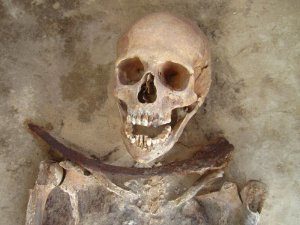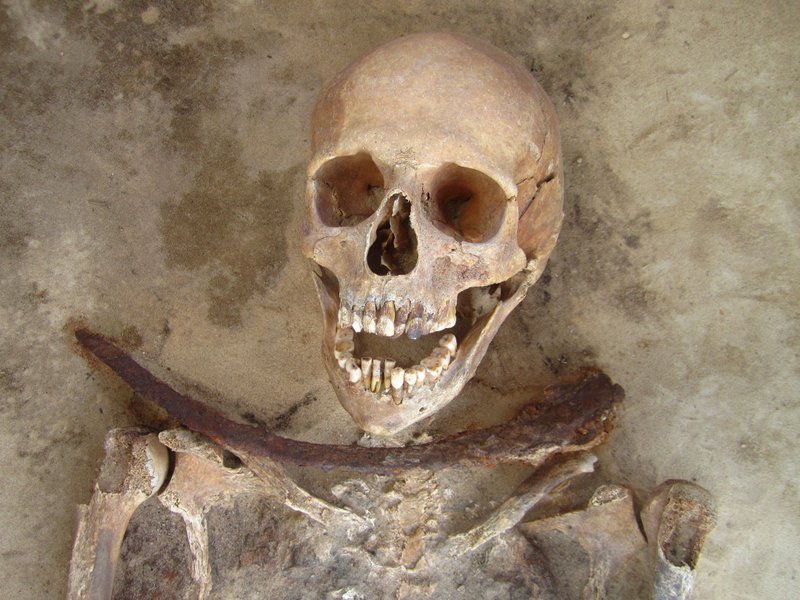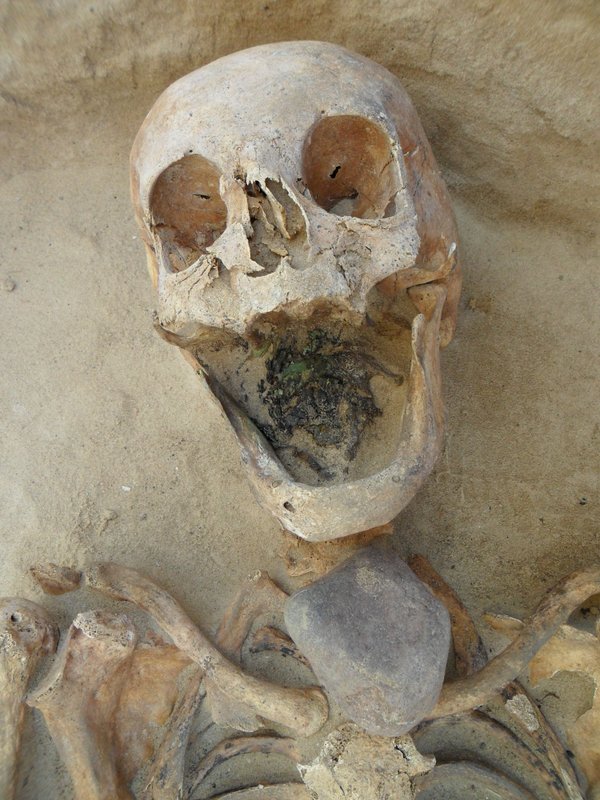
Potential ‘vampires’ buried in Poland with sickles and rocks placed across their corpses were likely local people known by their community before death, say researchers in a study published in the open-access journal PLOS ONE by Lesley Gregoricka from University of South Alabama and colleagues.
Archaeologists and other scientists who have exhumed the medieval and post-medieval skeletal remains of individuals in cemeteries across Europe in the course of their research have long known about burials of individuals who were thought to be potential ‘vampires’, or the ‘undead’. They know this by the peculiar features associated with the skeletal remains within the graves, objects such as sickles placed across the bodies, large stones placed over the neck or under the chins, iron bars or ‘stakes’ inserted through the chest area, or bricks or stones inserted within the cavity between the madible and the cranium (the mouth). They are considered indicators of apotropaic burial practices, or bodily treatments to the deceased within their coffins or graves designed to prevent them from returning to life and rising out of their graves to haunt, kill or eat the living. Only a minority of burials across Europe have exhibited these characteristics, but the practice is a reflection of a variety of cultural or religious beliefs that have inspired or spawned the more modern, popular conceptions in literature and the media about Dracula and vampires within the horror genre—a fascination and source of entertainment for generations.
Beginning in 2008, excavations carried out by an international team at the ‘Drawsko 1’ post-medieval cemetery site in northwestern Poland revealed six unusual graves, with skeletal remains dated to the 17th – 18th century showing sickles across the bodies or large rocks under the chins of select individuals. Though unusual, these burials were among hundreds of other normal burials. The researchers at the site have interpreted them to be apotropaic burials.
“In Polish folklore……the soul and the body are distinct entities that separate upon a person’s death,” write Lesley A. Gregoricka of the University of South Alabama and colleagues in the report. “Souls, the majority of which are harmless, leave the body and continue to inhabit the earth for 40 days after death. However, a small minority of these souls were seen as a direct threat to the living and at risk of becoming a vampire, particularly those who were marginalized in life for having an unusual physical appearance, practicing witchcraft, perishing first during an epidemic, committing suicide, being unbaptized or born out of wedlock, or being an outsider to the community.”*
___________________________________
 Individual 49/2012 (30-39 year old female) is shown with a sickle placed across the neck. Courtesy Amy Scott
Individual 49/2012 (30-39 year old female) is shown with a sickle placed across the neck. Courtesy Amy Scott
____________________________________
 Individual 60/2010 (60+ year old female) is shown with a stone placed directly on top of the throat. Courtesy Gregoricka et al.
Individual 60/2010 (60+ year old female) is shown with a stone placed directly on top of the throat. Courtesy Gregoricka et al.
____________________________________
In the study, Gregoricka and her colleagues analyzed the remains of 60 of the total of 285 buried skeletal remains unearthed in the excavations, including those of five of the six “special” or deviant, apotropaic, burials, by using radiometric strontium isotope analysis of dental enamel samples. The study was designed to determine whether the bodies selected for apotropaic burial rites were local or immigrants, one factor that can be scientifically tested. The research methodology used is important because strontium isotopes are absorbed by the flora and fauna of local ecosystems, which include humans, by the weathering or breakdown of bedrock into the soils and groundwater. “Because strontium is structurally similar to calcium, as humans consume these plants and animals, small amounts of strontium absorbed by the intestines substitute for calcium in the formation of enamel and bone hydroxyapatite,” wrote Gregoricka, et al. in the report. “Strontium uptake into the human skeleton is primarily determined by these consumed foods, and because the 87Sr/86Sr ratios within these products are a direct reflection of the distinct isotopic composition of a particular region’s underlying geology, biogeochemical signatures in human dental enamel (which form only during childhood) offer a useful means of evaluating childhood geographic residence and mobility in the past.”*
The team’s conclusion: The ‘vampires’ were local. They did not immigrate into the community from the outside, often cited historically by residents of communities during the 17th and 18th centuries as a reason for the introduction of evil elements into the social structure. The data thus indicated that they had to be perceived with suspicion in some other way. The study authors suggest one alternate explanation could be related to the cholera epidemics in Eastern Europe during the 17th century. “People of the post-medieval period did not understand how disease was spread, and rather than a scientific explanation for these epidemics, cholera and the deaths that resulted from it were explained by the supernatural – in this case, vampires,” said Dr. Gregoricka. “However,” cautioned Gregoricka in the report,”because cholera kills quickly and does not leave behind visible markers on the skeleton, it is unclear if this is the case at Drawsko.”*
The research study was published November 26, 2014 in the open access journal, PLOS ONE.
A more extensive feature article about the archaeology of ‘vampires’ will be published in the Winter 2015 issue of Popular Archaeology Magazine.
______________________________________
*Gregoricka LA, Betsinger TK, Scott AB, Polcyn M (2014) Apotropaic Practices and the Undead: A Biogeochemical Assessment of Deviant Burials in Post-Medieval Poland. PLoS ONE 9(11): e113564. doi:10.1371/journal.pone.0113564
_______________________________________________
Just released!
The special new premium quality print edition of Popular Archaeology Magazine. A beautiful volume for the coffee table.
Travel and learn with Far Horizons.
Read about the most fascinating discoveries with a premium subscription to Popular Archaeology Magazine. Find out what Popular Archaeology Magazine is all about. AND MORE:
On the go? Get the smartphone version of Popular Archaeology as an app or as an ebook.
Popular Archaeology’s annual Discovery Edition eBook is a selection of the best stories published in Popular Archaeology Magazine in past issues, with an emphasis on some of the most significant, groundbreaking, or fascinating discoveries in the fields of archaeology and paleoanthropology and related fields. At least some of the articles have been updated or revised specifically for the Discovery edition. We can confidently say that there is no other single issue of an archaeology-related magazine, paper print or online, that contains as much major feature article content as this one. The latest issue, volume 2, has just been released. Go to the Discovery edition page for more information.








